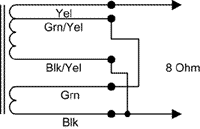Hi all,
I am planning to build the 807 ultralinear PP amp as described in Mr. J. C. Morrison's Fi Primer (http://tinpan.fortunecity.com/saints/668/primer/807-pp.gif)
I have some doubts, and would be very thankful if anybody could clear those.
1. What is the power transformer rating? Is it:
Primary : 230V AC (local supply in my area is 230 V AC)
Secondary : 0-220V @ 500 mA (for B+)
0-6.3V @ 5A (for filaments)
0-100V @ 500mA (for -100V)
2.Can I have multiple secondary windings in the same transformer for B+, filaments and -100V supply, or should these be seperate transformers?
3. From the anode of 6SL7, after the 68K 1W resistor, and the 5K 1W resistor, an arrow is shown. Is this to be connected to B+?
4. In the schematic, just before the 807s, I see a resistor network comprising of a 15K, two 5K Lin pots in parallel, and a 1.1 K resistor connected between B+ (I think) and ground. What is the purpose of this? What is the setting for the 5K linear pot and how is it arrived at?
5. In the schematic, the B+ is shown as 230V, but if I use a power transformer with 220V Ac secondary, use full wave rectification as shown, and use a 800uF capacitor for filtering, won't the DC output be somewhere around 311 V?
Thanks in advance for any assistance.
regards,
rk
I am planning to build the 807 ultralinear PP amp as described in Mr. J. C. Morrison's Fi Primer (http://tinpan.fortunecity.com/saints/668/primer/807-pp.gif)
I have some doubts, and would be very thankful if anybody could clear those.
1. What is the power transformer rating? Is it:
Primary : 230V AC (local supply in my area is 230 V AC)
Secondary : 0-220V @ 500 mA (for B+)
0-6.3V @ 5A (for filaments)
0-100V @ 500mA (for -100V)
2.Can I have multiple secondary windings in the same transformer for B+, filaments and -100V supply, or should these be seperate transformers?
3. From the anode of 6SL7, after the 68K 1W resistor, and the 5K 1W resistor, an arrow is shown. Is this to be connected to B+?
4. In the schematic, just before the 807s, I see a resistor network comprising of a 15K, two 5K Lin pots in parallel, and a 1.1 K resistor connected between B+ (I think) and ground. What is the purpose of this? What is the setting for the 5K linear pot and how is it arrived at?
5. In the schematic, the B+ is shown as 230V, but if I use a power transformer with 220V Ac secondary, use full wave rectification as shown, and use a 800uF capacitor for filtering, won't the DC output be somewhere around 311 V?
Thanks in advance for any assistance.
regards,
rk
Hi RK,
I've never seen this amp before, but I'm partial to 807's myself.
<b>1. What is the power transformer rating? Is it:
Primary : 230V AC (local supply in my area is 230 V AC)
Secondary : 0-220V @ 500 mA (for B+)
0-6.3V @ 5A (for filaments)
0-100V @ 500mA (for -100V) </b>
Primary: 230V as that's what's local for you.
Secondaries: I'm assuming that both channels are fed from the same supply.
- B+: 0-220V @ 500mA. This is nearly what the circuit is drawing at idle. I would have a minimum of 1.5 - 2 x this myself.
- filaments: 5A @ 6.3V looks a bit marginal to me. Each 807 draws 0.9A, each 6SL7 draws 0.3A, so that comes to (4x0.9+3x0.3= 4.5A). Personally I prefer to overrate and run things like transformers cooler, so I'd have a 6-8A winding at least.
- 0-100V@100mA max and even that's way overkill. Each 6SL7 will only be drawing a couple of mA each (1 -1.5 ea at idle), so it needs to sink 4 x 3 mA roughly. The bias network for the 807s is drawing roughly 5.5mA
<b>2.Can I have multiple secondary windings in the same transformer for B+, filaments and -100V supply, or should these be seperate transformers?</b>
Yes, you can have all the windings on the same transformer core, so long as it is specified for the total current draw and expected temperature rise.
If you are going to get the power transformer custom made, then it might be cheaper to get a 230-230 isolation transformer, plus others for the filaments and -100V bias, buying off-the -shelf items. If you are getting one wound, spend another couple of dollars and get an electrostatic shield installed. It will reduce a lot of the mains induced noise in the amp. I like EI cores for the same reason.
<b>3. From the anode of 6SL7, after the 68K 1W resistor, and the 5K 1W resistor, an arrow is shown. Is this to be connected to B+? </b>
Yes.
<b>4. In the schematic, just before the 807s, I see a resistor network comprising of a 15K, two 5K Lin pots in parallel, and a 1.1 K resistor connected between B+ (I think) and ground. What is the purpose of this? What is the setting for the 5K linear pot and how is it arrived at?</b>
This network connects to the -100V rail, and is a resistive divider network to set the bias for the 807s. This is called fixed bias. This network will adjust between -5.2V and -28.9V. I don't know what level of bias JCM wanted on the tubes, but I'd guess somewhere in the middle of the range, say 18-20V. Do you have any other information as to the correct bias voltage?
<b>5. In the schematic, the B+ is shown as 230V, but if I use a power transformer with 220V Ac secondary, use full wave rectification as shown, and use a 800uF capacitor for filtering, won't the DC output be somewhere around 311 V?</b>
Theoretically yes, you'll get 311V at the top of the first cap. Throwing some numbers into quickly PSUD, I come up with between 290 and 255V, because you'll have a voltage drop across the 10 ohm resistor, dependent upon the current draw of the circuit.
==========================================
After I'd typed all the stuff above, I found in my datasheets for the 807 a set of specs for class A tetrode operation, that are quite similar to the circuit JCM has designed.
Plate V: 250V
Screen V: 250V
Plate current (no signal): 120mA/tube
Plate current (max sig): 140mA/tube
Load plate-to-plate: 5k
Grid voltage: -16V (answer to Q4)
Power output: 14.5W
THD: 2% (remember this is tetrode, not ultra-linear, and there is no NFB applied)
I also found the description of the 807PP amp on the same site you linked the schematic from: 20W @0.1% UL. The datasheet specs just above look pretty close.
Sorry my response was so disjointed, but I hoped it helped some anyway. I'll look at it further, and if you have any more questions, I'll do my best to answer them.
Cheers
Brett
I've never seen this amp before, but I'm partial to 807's myself.
<b>1. What is the power transformer rating? Is it:
Primary : 230V AC (local supply in my area is 230 V AC)
Secondary : 0-220V @ 500 mA (for B+)
0-6.3V @ 5A (for filaments)
0-100V @ 500mA (for -100V) </b>
Primary: 230V as that's what's local for you.
Secondaries: I'm assuming that both channels are fed from the same supply.
- B+: 0-220V @ 500mA. This is nearly what the circuit is drawing at idle. I would have a minimum of 1.5 - 2 x this myself.
- filaments: 5A @ 6.3V looks a bit marginal to me. Each 807 draws 0.9A, each 6SL7 draws 0.3A, so that comes to (4x0.9+3x0.3= 4.5A). Personally I prefer to overrate and run things like transformers cooler, so I'd have a 6-8A winding at least.
- 0-100V@100mA max and even that's way overkill. Each 6SL7 will only be drawing a couple of mA each (1 -1.5 ea at idle), so it needs to sink 4 x 3 mA roughly. The bias network for the 807s is drawing roughly 5.5mA
<b>2.Can I have multiple secondary windings in the same transformer for B+, filaments and -100V supply, or should these be seperate transformers?</b>
Yes, you can have all the windings on the same transformer core, so long as it is specified for the total current draw and expected temperature rise.
If you are going to get the power transformer custom made, then it might be cheaper to get a 230-230 isolation transformer, plus others for the filaments and -100V bias, buying off-the -shelf items. If you are getting one wound, spend another couple of dollars and get an electrostatic shield installed. It will reduce a lot of the mains induced noise in the amp. I like EI cores for the same reason.
<b>3. From the anode of 6SL7, after the 68K 1W resistor, and the 5K 1W resistor, an arrow is shown. Is this to be connected to B+? </b>
Yes.
<b>4. In the schematic, just before the 807s, I see a resistor network comprising of a 15K, two 5K Lin pots in parallel, and a 1.1 K resistor connected between B+ (I think) and ground. What is the purpose of this? What is the setting for the 5K linear pot and how is it arrived at?</b>
This network connects to the -100V rail, and is a resistive divider network to set the bias for the 807s. This is called fixed bias. This network will adjust between -5.2V and -28.9V. I don't know what level of bias JCM wanted on the tubes, but I'd guess somewhere in the middle of the range, say 18-20V. Do you have any other information as to the correct bias voltage?
<b>5. In the schematic, the B+ is shown as 230V, but if I use a power transformer with 220V Ac secondary, use full wave rectification as shown, and use a 800uF capacitor for filtering, won't the DC output be somewhere around 311 V?</b>
Theoretically yes, you'll get 311V at the top of the first cap. Throwing some numbers into quickly PSUD, I come up with between 290 and 255V, because you'll have a voltage drop across the 10 ohm resistor, dependent upon the current draw of the circuit.
==========================================
After I'd typed all the stuff above, I found in my datasheets for the 807 a set of specs for class A tetrode operation, that are quite similar to the circuit JCM has designed.
Plate V: 250V
Screen V: 250V
Plate current (no signal): 120mA/tube
Plate current (max sig): 140mA/tube
Load plate-to-plate: 5k
Grid voltage: -16V (answer to Q4)
Power output: 14.5W
THD: 2% (remember this is tetrode, not ultra-linear, and there is no NFB applied)
I also found the description of the 807PP amp on the same site you linked the schematic from: 20W @0.1% UL. The datasheet specs just above look pretty close.
Sorry my response was so disjointed, but I hoped it helped some anyway. I'll look at it further, and if you have any more questions, I'll do my best to answer them.
Cheers
Brett
I have quite a few 807s -- this amp looks interesting.
What is the rationale behind cross-connecting the cathodes of the 807 to the secondary of the OPT?
dave
What is the rationale behind cross-connecting the cathodes of the 807 to the secondary of the OPT?
dave
The connection of the 807 cathodes to the OPT is for negative feedback. The 8 ohm tapping is the centre tap of the secondary. If the voltage feed back to the cathode is in phase with the grid voltage then the change in grid-to-cathode voltage is reduced, therefore negative feedback.
Actually, now I think about it, the impedance ratio is the turns ratio squared, so is the 8 ohm tapping actually the centre tap of the complete 16 ohm secondary? What I mean is this: Lets say we had this transformer and it had an 8 ohm secondary winding and it had 8 turns on it's secondary. We then decided we wanted it to be a 16 ohm winding instead. So 8 turns squared = 64. Double that = 128. Square root of 128 = ~11.31 turns. So we have 8 turns and 3.31 turns either side of the 8 ohm tapping. It may be the impedance centre tap but it is not the voltage ct. SO if we take negative feedback from this arrangement then it will be pretty lopsided! 😱
Actually, now I think about it, the impedance ratio is the turns ratio squared, so is the 8 ohm tapping actually the centre tap of the complete 16 ohm secondary? What I mean is this: Lets say we had this transformer and it had an 8 ohm secondary winding and it had 8 turns on it's secondary. We then decided we wanted it to be a 16 ohm winding instead. So 8 turns squared = 64. Double that = 128. Square root of 128 = ~11.31 turns. So we have 8 turns and 3.31 turns either side of the 8 ohm tapping. It may be the impedance centre tap but it is not the voltage ct. SO if we take negative feedback from this arrangement then it will be pretty lopsided! 😱
Circlotron said:The connection of the 807 cathodes to the OPT is for negative feedback
<snip>
negative feedback from this arrangement then it will be pretty lopsided!
Thanx... a conversion to cathode bias would be a consideration.
dave
Correction
I just realised I made a mistake in the plate current values in my first post. It should be
Plate current (no signal): 120mA/tube pair
Plate current (max sig): 140mA/tube pair
I'll run the simulation again in the morning and see what the transformer secondary voltage for the B+ supply should be with the lower current draw. 500mA should be enough for the B+ winding now. Sorry for the confusion.
Dave (planet10) said
<b>a conversion to cathode bias would be a consideration.</b>
I've never been a big fan of fixed bias myself. I wondered whether you'd seen this old Sound Practices article on it.
http://www.southernelectricaudio.com/images/fixbias.pdf
There's also a great and very detailed STC datasheet for the 807 here. Best I've seen by a long way, but 5.5M in size.
http://www.retrovox.com.au/STC807.pdf
I just realised I made a mistake in the plate current values in my first post. It should be
Plate current (no signal): 120mA/tube pair
Plate current (max sig): 140mA/tube pair
I'll run the simulation again in the morning and see what the transformer secondary voltage for the B+ supply should be with the lower current draw. 500mA should be enough for the B+ winding now. Sorry for the confusion.
Dave (planet10) said
<b>a conversion to cathode bias would be a consideration.</b>
I've never been a big fan of fixed bias myself. I wondered whether you'd seen this old Sound Practices article on it.
http://www.southernelectricaudio.com/images/fixbias.pdf
There's also a great and very detailed STC datasheet for the 807 here. Best I've seen by a long way, but 5.5M in size.
http://www.retrovox.com.au/STC807.pdf
Re: Correction
I tended toward cathode bias based on Allen Wright's preferences, but the above article really nailed it for me.
I got scans of this same datasheet from a fellow in Perth a while back.
dave
Brett said:I've never been a big fan of fixed bias myself. I wondered whether you'd seen this old Sound Practices article on it.
http://www.southernelectricaudio.com/images/fixbias.pdf
I tended toward cathode bias based on Allen Wright's preferences, but the above article really nailed it for me.
There's also a great and very detailed STC datasheet for the 807 here. Best I've seen by a long way, but 5.5M in size.
I got scans of this same datasheet from a fellow in Perth a while back.
dave
Hi all,
Thanks for all the feedback.
Shall I go ahead and build the amp as it is and then think of any modifications after listening? Could any of you suggest a good output transformer for this circuit?
Thanks and regards,
rk
Thanks for all the feedback.
Shall I go ahead and build the amp as it is and then think of any modifications after listening? Could any of you suggest a good output transformer for this circuit?
Thanks and regards,
rk
arkay said:Could any of you suggest a good output transformer for this circuit?
Dynaco ST70 OPTs
These R-Core OPTs -- about 1/2 way down the page.
dave
Hi Dave,
I visited the link for the R-core OPTs and saw the specs of RX-40-5
Push-Pull 5,000 ohms 40W type Audio Output Transformer. The said OPT has only a single 6-Ohm secondary, whereas in the amp schematic I see the cathodes of 807s connected to the 16 Ohm tap and common in the secondary, apart from 4 Ohm tap grounded through a 1 Ohm 5 W resistor. I know that I am sounding silly, but if I use the said R core OPT, how will the connections be made?
Thanks in advance,
rk
I visited the link for the R-core OPTs and saw the specs of RX-40-5
Push-Pull 5,000 ohms 40W type Audio Output Transformer. The said OPT has only a single 6-Ohm secondary, whereas in the amp schematic I see the cathodes of 807s connected to the 16 Ohm tap and common in the secondary, apart from 4 Ohm tap grounded through a 1 Ohm 5 W resistor. I know that I am sounding silly, but if I use the said R core OPT, how will the connections be made?
Thanks in advance,
rk
arkay said:specs of RX-40-5
Push-Pull 5,000 ohms 40W type Audio Output Transformer. The said OPT has only a single 6-Ohm secondary, whereas in the amp schematic I see the cathodes of 807s connected to the 16 Ohm tap and common in the secondary, apart from 4 Ohm tap grounded through a 1 Ohm 5 W resistor.
You are right. That one would only work if you were converting it to cathode bias.
This is the 807 (1625 is just a different heater V) that i like best... i'd probably use something like 6922 or 6H30 on the front.
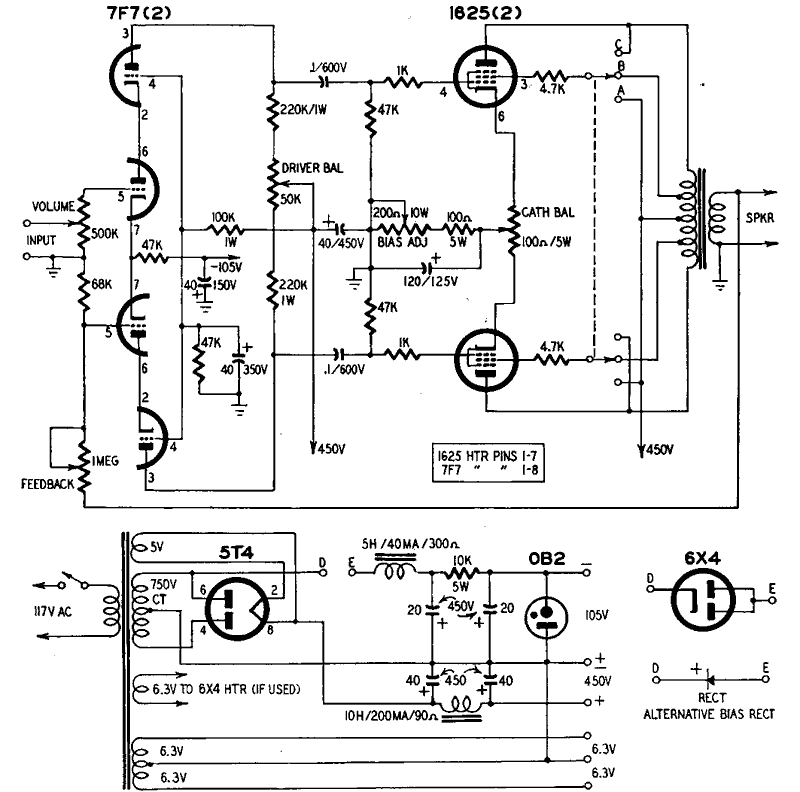
I have the whole article scanned if you are interested.
dave
<b>Shall I go ahead and build the amp as it is and then think of any modifications after listening? Could any of you suggest a good output transformer for this circuit?</b>
Yes, just build it for now as it is in the schematic, and then tweak. I've re-run the power supply sims and I keep getting a bit higher B+ for each channel, around 250-260V. This is a lower value than I probably would have picked for the circuit. However, the amp has fixed bias, and the tubes are run well within their ratings, so I wouldn't have any concern. It might be worth setting the bias to 17-18V if you end up with the B+ around 270V. If you find a transformer with a secondary as low as 200V, it should still work fine.
The output transformer is spec'd as 5k - 7k plate-to-plate, so look at
<a href="http://www.lundahl.se">Lundahl</a> LL1663 (5k) or LL1620 (6k) available from <a href="">diyparadiso in Italy</a> for $US70 and $US104 respectively. They also have a good guide to chosing trannies and are nice guys to deal with.
Hammond 1650F - 5k, 30W $US50~
Hammond 1659G - 6k6 35W $US55~
Hammond 1650P - 6k6 60W $US72
Prices are from <a href="http://www.tubesandmore.com/">Antique</a>
<a href="http://www.magnequest.com/">MagneQuest</a> can also do excellent PP trannies. Mike has all the winding specs for Dyna, Peerless and others. His reputation is very good.
Bartolucci have a great reputation, but are quite expensive. Available from <a href="http://www.audiokit.it/ENG/Frames/Introduction1.htm">Audiokit Italy</a> who also have a lot of great parts and are friendly. I'm sending off another order to them tonight.
<a href="http://www.tektron-italia.com">Tektron-Italia</a> also make PP trannies, but you'd have to email Attilio and ask for specifics. Their SE kits and transformers have a great reputation. I've ordered some chokes from him based on his reputation, but they're in transit so I can't give personal opinions yet.
In pre-loved trannies you could also look at any of the Fisher etc iron of about 30W that ran tubes like 7591/7868 or 6V6, 6L6, 5881 etc. These are often 6k6 primaries and ran the tubes at similar levels. For example the ones out of my 800B would probably work fine.
John Atwood did a series of performance tests on mainly older transformers about a decade ago. Read all about it <a href="http://www.one-electron.com/Trans_Tests.html">here</a> to get some ideas of whats suitable and good.
I (personally) disagree with Dave's suggestion of the A470. The primary Z is too low for my taste at 4k3, and I would go for something at the higher end, but the 470, or the Magnequest re-issues are excellent transformers, and would probably work very well in the circuit. If you find some of these at a good price, try them as they can usually be resold easily for little or no loss.
The R cores Dave suggested look very nice too. Dave have you or anyone you know used these R cores? The price and specs are good.
Handwound transformers in the US (qqqqqqqq on ebay) have been getting a fair bit of bad press on AA and other forums of late due to poor specs. They are very cheap, but I'd spend my money elsewhere.
Cheers
Yes, just build it for now as it is in the schematic, and then tweak. I've re-run the power supply sims and I keep getting a bit higher B+ for each channel, around 250-260V. This is a lower value than I probably would have picked for the circuit. However, the amp has fixed bias, and the tubes are run well within their ratings, so I wouldn't have any concern. It might be worth setting the bias to 17-18V if you end up with the B+ around 270V. If you find a transformer with a secondary as low as 200V, it should still work fine.
The output transformer is spec'd as 5k - 7k plate-to-plate, so look at
<a href="http://www.lundahl.se">Lundahl</a> LL1663 (5k) or LL1620 (6k) available from <a href="">diyparadiso in Italy</a> for $US70 and $US104 respectively. They also have a good guide to chosing trannies and are nice guys to deal with.
Hammond 1650F - 5k, 30W $US50~
Hammond 1659G - 6k6 35W $US55~
Hammond 1650P - 6k6 60W $US72
Prices are from <a href="http://www.tubesandmore.com/">Antique</a>
<a href="http://www.magnequest.com/">MagneQuest</a> can also do excellent PP trannies. Mike has all the winding specs for Dyna, Peerless and others. His reputation is very good.
Bartolucci have a great reputation, but are quite expensive. Available from <a href="http://www.audiokit.it/ENG/Frames/Introduction1.htm">Audiokit Italy</a> who also have a lot of great parts and are friendly. I'm sending off another order to them tonight.
<a href="http://www.tektron-italia.com">Tektron-Italia</a> also make PP trannies, but you'd have to email Attilio and ask for specifics. Their SE kits and transformers have a great reputation. I've ordered some chokes from him based on his reputation, but they're in transit so I can't give personal opinions yet.
In pre-loved trannies you could also look at any of the Fisher etc iron of about 30W that ran tubes like 7591/7868 or 6V6, 6L6, 5881 etc. These are often 6k6 primaries and ran the tubes at similar levels. For example the ones out of my 800B would probably work fine.
John Atwood did a series of performance tests on mainly older transformers about a decade ago. Read all about it <a href="http://www.one-electron.com/Trans_Tests.html">here</a> to get some ideas of whats suitable and good.
I (personally) disagree with Dave's suggestion of the A470. The primary Z is too low for my taste at 4k3, and I would go for something at the higher end, but the 470, or the Magnequest re-issues are excellent transformers, and would probably work very well in the circuit. If you find some of these at a good price, try them as they can usually be resold easily for little or no loss.
The R cores Dave suggested look very nice too. Dave have you or anyone you know used these R cores? The price and specs are good.
Handwound transformers in the US (qqqqqqqq on ebay) have been getting a fair bit of bad press on AA and other forums of late due to poor specs. They are very cheap, but I'd spend my money elsewhere.
Cheers
Brett said:I (personally) disagree with Dave's suggestion of the A470. The primary Z is too low for my taste at 4k3, and I would go for something at the higher end
I'll keep that in mind. Someone mentioned to me that they might work -- i will be using mine with a set of red-bottle Tesla EL-34s.
The R cores Dave suggested look very nice too. Dave have you or anyone you know used these R cores? The price and specs are good.
A couple guys on the JoeList ordered some and early reports are promising, but no in-depth reports yet.
Handwound transformers in the US (qqqqqqqq on ebay) have been getting a fair bit of bad press on AA and other forums of late due to poor specs. They are very cheap, but I'd spend my money elsewhere.
A thread on this recently also on the JoeList. A number of people have dealt with him, about 75% seemed to not real pleased.
dave
Hi,
I was going through the Hammond catalogue, and found the following PP - OPT.
Model : 1645
Audio Watts : 30
Primary Impedence : 5000 ct
Max. DC per side : 128 mA
Secondary Impedence : 4-8-16 Ohms and 70 V
The link to the schematic of the OPT as shown in the catalogue is given below:
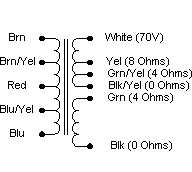
The secondary connection for 4 Ohms load is:
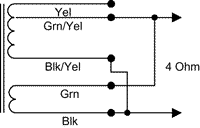
The secondary connection for 8 Ohms load is :
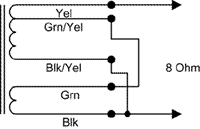
The secondary connection for 16 Ohms load is:
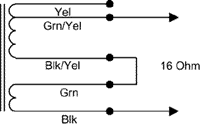
Can I use this OPT?
If so, how do I wire the feedback?
Any help would be highly appreciated.
Thanks and regards,
rk
I was going through the Hammond catalogue, and found the following PP - OPT.
Model : 1645
Audio Watts : 30
Primary Impedence : 5000 ct
Max. DC per side : 128 mA
Secondary Impedence : 4-8-16 Ohms and 70 V
The link to the schematic of the OPT as shown in the catalogue is given below:

The secondary connection for 4 Ohms load is:

The secondary connection for 8 Ohms load is :

The secondary connection for 16 Ohms load is:

Can I use this OPT?
If so, how do I wire the feedback?
Any help would be highly appreciated.
Thanks and regards,
rk
Feedback is typically wired from the 16 ohm tap to the cathode of your driver tube. If your schematic does not give you a value for the resister in the circuit putting a 100K pot in and turning till it sounds the best, removing it and measuring the resistance will get you very close.
Hi all,
Looks like I phrased my doubt in a manner which is not clear.
I want to use Hammond OPT model 1645. The specs for the same are given in my previous post. Is this OPT OK?
My doubt is, if I wire the secondary of the OPT to connect to 8 Ohms load, (as shown below), is it correct to connect the cathode of the top 807 to the Black coloured wire in the secondary, and the cathode of the bottom 807 to the yellow coloured wire in the secondary?
To which wire in the secondary should I connect the 1 Ohm 5W resistor, the other end of which is grounded?
Any assistance would be highly appreciated.
Thanks in advance,
regards,
rk
Looks like I phrased my doubt in a manner which is not clear.
I want to use Hammond OPT model 1645. The specs for the same are given in my previous post. Is this OPT OK?
My doubt is, if I wire the secondary of the OPT to connect to 8 Ohms load, (as shown below), is it correct to connect the cathode of the top 807 to the Black coloured wire in the secondary, and the cathode of the bottom 807 to the yellow coloured wire in the secondary?
To which wire in the secondary should I connect the 1 Ohm 5W resistor, the other end of which is grounded?
Any assistance would be highly appreciated.
Thanks in advance,
regards,
rk
Attachments
The Hammond will be at its best only when you use the 16 Ohm tap. When wired for 16, the 4 Ohm tap is the center tap. If you're using 4 or 8, you'll only load half of the secondary (Since they're intended to be in parallel) and coupling will suffer. So the high frequency response will not be as good as it could be. But it may be more than good enough - I don't know.
I've considered building this - I might yet - and I'll probably use Hammond Iron, unless something vintage turns up. A dozen 6BG6s (like an 807, but with octal base) are looking for work...
I've considered building this - I might yet - and I'll probably use Hammond Iron, unless something vintage turns up. A dozen 6BG6s (like an 807, but with octal base) are looking for work...
Planet10,
Dave it has been almost 9 years since you posted the 807 schematic in this thread. Are you still able to provide the complete article on that amp.
I would very much like to give it a read and try this. The layout is not too complicated and would work nice for a first time tube build. I need to get something assembled so as to begin learning the particulars of tubes. I do not need to have something overly complex for a first go.
Tad
Dave it has been almost 9 years since you posted the 807 schematic in this thread. Are you still able to provide the complete article on that amp.
I would very much like to give it a read and try this. The layout is not too complicated and would work nice for a first time tube build. I need to get something assembled so as to begin learning the particulars of tubes. I do not need to have something overly complex for a first go.
Tad
If you are interested in single ended class A, check out the schematics to my amplifier i built. I can give additional information if you need any. I did 5 channels but you can do as few/many as you want with my design as long as your power supply can keep up
http://www.diyaudio.com/forums/tubes-valves/183814-5-1-channel-807-se-amplifier.html
http://www.diyaudio.com/forums/tubes-valves/183814-5-1-channel-807-se-amplifier.html
You are right. That one would only work if you were converting it to cathode bias.
This is the 807 (1625 is just a different heater V) that i like best... i'd probably use something like 6922 or 6H30 on the front.
An externally hosted image should be here but it was not working when we last tested it.
I have the whole article scanned if you are interested.
dave
A more modern version (uses current sources) of this topology is the PP-1c amp of the late Allen Wright. If you change the cascodes of triodes to pentodes you have the Engineers Amp of Pete Millett.
I built both and they are both great.
- Status
- Not open for further replies.
- Home
- Amplifiers
- Tubes / Valves
- 807 pp amp - help
